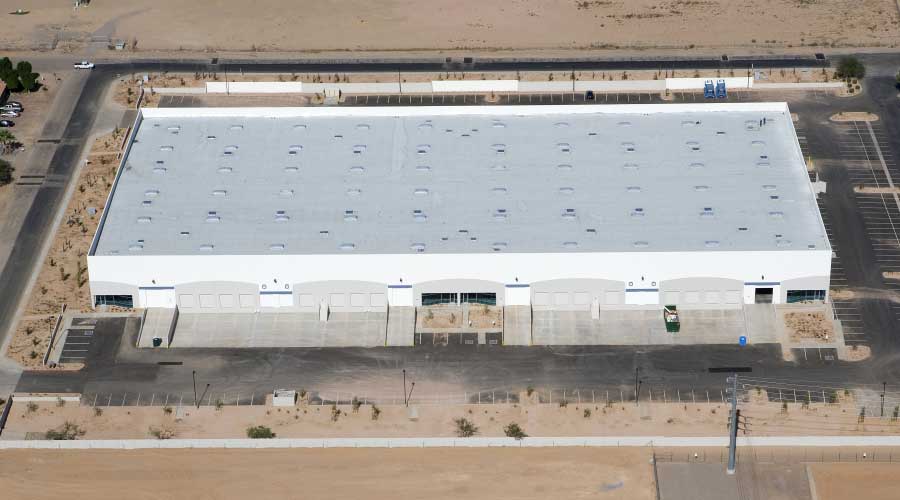When Roofing Replacement Is the Best Option
Once the determination is made that a roof needs to be replaced, managers should follow these best practices to match the roofing type to the needs of their facility.
Compared with a recover, a roof replacement entails greater expense and effort. A full roof assembly replacement goes beyond the roof membrane and includes considerations for insulation, fire classification, wind uplift, and structural roof deck and diaphragm performance. Modern building code requirements are more stringent than those 20 years or even 10 years ago. So when planning a roof replacement project, managers should be aware of these considerations:
Structural diaphragm analysis. Depending on governing code, a licensed engineer might need to analyze the structural diaphragm of the roof and roof-to-wall connections for compliance with wind loading as specified in the IBC.
Insulation thickness. Current energy conservation building codes can include minimum insulating requirements ranging from R-2- to R-30. Where the existing roof deck is flat and tapered insulation creates the required slope to drains, insulation depth can be significantly more than 6 inches in some areas. If existing building elements, such as low parapet walls or penthouse thresholds, were designed for a roof system with 2 inches of insulation, these components will need to be modified to accommodate the new finished roof level.
Drains. Managers should analyze existing drains to confirm that their location and sizing appropriately accommodate rainfall for pre-design. The replacement of drains and the addition of new drains when necessary requires access to the underside of the roof deck. Suspended or finished ceiling will need to be removed and reinstalled accordingly.
Selecting a new low-slope roof
Once a manager has weighed the options and elected a roof replacement approach, the next point of discussion is the type of roofing system and membrane. Although it might be simplest to stick to what a manager knows, an analysis of current needs and new code requirements is advisable. When selecting an appropriate roof membrane system, managers need to consider roof usage, environmental factors, and budget, among other design criteria.
Roof systems that serve as supplementary spaces for tenant activities require a robust assembly that provides protection for the membrane and a surface for foot traffic. This system likely will be an inverted or protected roof membrane assembly — IRMA or PRMA — where insulation and overburden are installed on top of the membrane. Membranes appropriate for these systems include multi-ply bitumen, hot-applied rubberized, and reinforced liquid resin.
Green roof assemblies create an environment where water is consistently introduced to the overburden and where root systems prod lap seams between membrane sheets — not ideal in waterproofing. The heavy overburden creates a logistical and financial burden if leaks occur. Managers can mitigate these factors through the use of a seamless application, such as those provided by liquid-applied resin systems and hot-applied rubberized systems.
Roofs that serve solely as a waterproof cap to a building provide an opportunity to use the largest variety of membranes. Multi-ply bitumen systems, hot-applied rubberized systems and reinforced liquid resin systems provide superior performance, but less expensive options might provide near-equal performance.
Traditional or exposed membrane assemblies allow for budget-friendly single-ply systems, but managers should be aware that manufacturers provide single-ply membranes in different thicknesses.
Over time, foot traffic, water flow, ultraviolet radiation and exposure to the elements will erode the membrane surface. The thicker the membrane is, the longer it lasts, but this maxim is specific to the membrane material and does not take into consideration the roof installation and detailing, the performance of which rely on educated design and quality workmanship.
Environmental factors also might dictate or influence the use of a particular membrane type. For example, chronic exposure to caustic exhaust demands a membrane with suitable chemical properties, which will not prematurely deteriorate when subjected to the extreme environment. Caustic deposits require the use of membranes with a composition that has been tested and proven resilient to such exposure, such as a polyvinyl chloride (PVC) or ketone ethylene ester membrane.
Price points for roof membranes vary. Generally, single-ply membranes are comparatively low-cost systems with basic labor demands for installation. Multi-ply systems provide added redundancy, something always sought after in waterproofing and typically price higher than single-ply systems. Liquid-applied resin systems and hot-applied rubberized systems are commonly the highest priced assemblies, requiring onsite material preparation and labor-intensive installation but providing a seamless waterproofing membrane.
Best practices
Managers can use best practices to set up, verify and preserve the quality of a new roof. During the design phase, manufacturer visits, adhesion testing (for roof recover), and mockups are instrumental for quality control. For recover projects, infrared and capacitance testing can confirm that existing assemblies have not been compromised by water. If testing reveals limited water damage in the system, targeted repairs can be made before the recover application.
Following installation of the recover or new roof, installers should provide manufacturer maintenance guidelines. This literature includes information on the timing of routine inspections, what to look for during roof evaluations, general care and upkeep recommendations, and directions for notifying the manufacturer of issues.
Typical roof inspection items include: signs of stress; including wrinkles and blisters; evidence of mechanical abuse, such as punctures and cuts; unusual wear due to excessive foot traffic; and evidence of damage caused by chemical attack or other adverse reaction to substances.
Maintenance recommendations might include keeping the roof free of debris that might cause damage, cleaning the membrane with low-pressure water or soft-bristle brooms, and maintaining clear drains and scuppers.
A building’s roofing system is vital to its enjoyable use and longevity. Selecting an appropriate roof system and diligently maintaining the roof ultimately reduces issues and increases the return on investment.
Daniel L. Bishop, AIA — d.bishop@hoffarch.com — is a project architect in the Virginia office of Hoffmann Architects, an architecture and engineering firm specializing in the rehabilitation of building exteriors. He designs cost-effective, resilient solutions for building enclosure assemblies.
Related Topics:













